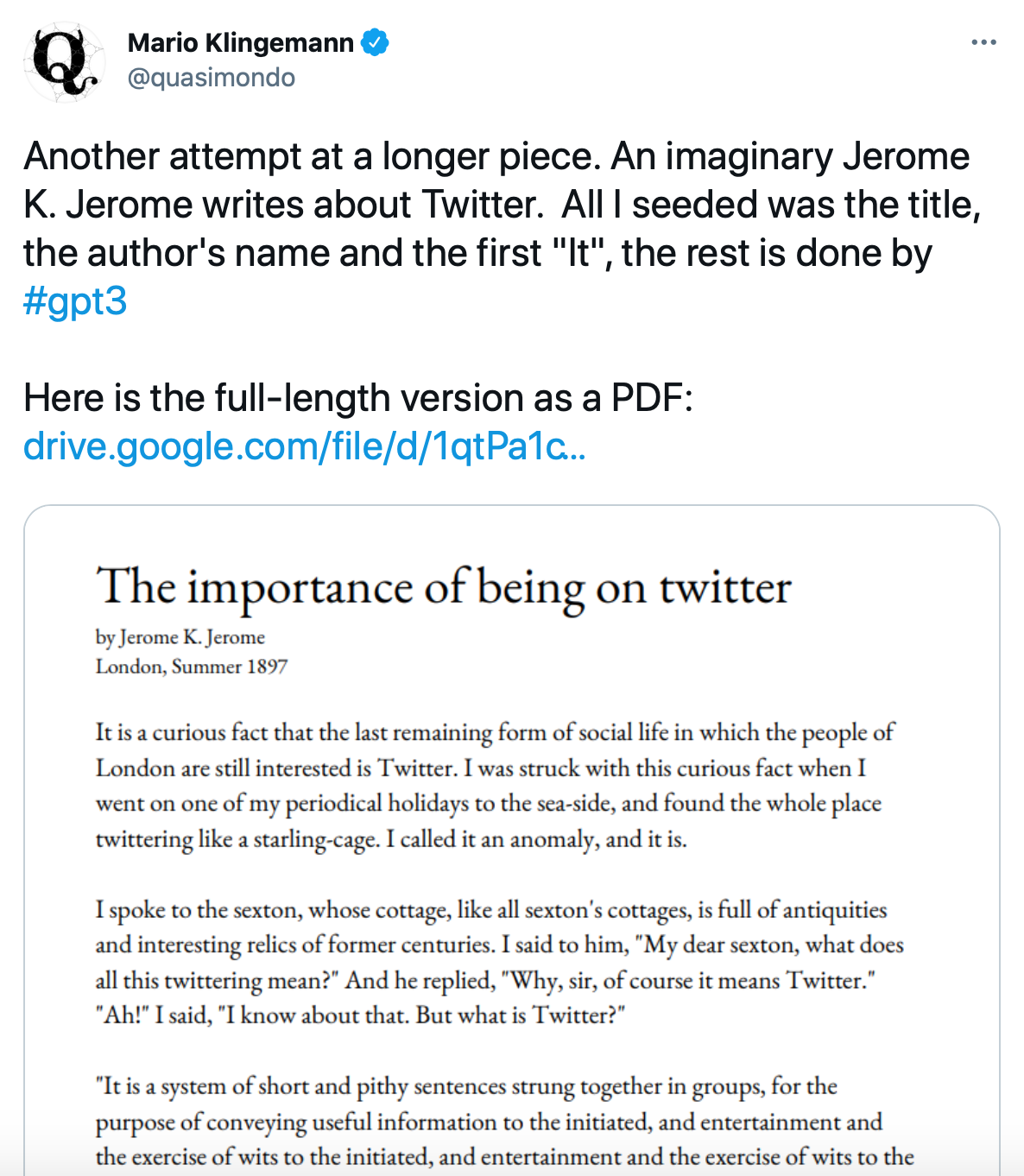Since the inception of artificial intelligence, humans everywhere have been left fearfully wondering: “Will a robot steal my job!?”
As it turns out, the answer is… maybe!
Telemarketers, receptionists, couriers, and proofreaders are among those who are potentially on the chopping block as AI becomes more advanced. If you’re curious about whether your job is in danger, you can enter your job title into the somewhat nerve-wracking website aptly named “Will Robots Take My Job?”
In this article, we’re taking a look at whether a new AI technology called “GPT-3” will add content marketers to the list of jobs in hot water.
Can AI technology really replace a human when it comes to writing content and website copy? Keep reading to find out!
What is GPT-3?

GPT-3 is an AI language model developed by OpenAI that was recently released in June 2020. Basically, GPT-3 is a version of natural language processing (NLP) that gives machines the ability to read, understand, and communicate using human languages.
Although NLP sounds pretty futuristic, it’s actually been around for many years and is more common than you might think. A common example of NLP is probably within arms reach of you right now. Apple’s Siri uses NLP to understand and respond to your random questions throughout the day. “Hey Siri, are robots taking over the world!? This article is scaring me!”
There are four main types or applications of natural language processing:
- Text classification: assigning a set of predefined categories to text based on its context
- Text summarization: condensing long text into a shorter version.
- Text generation: generating new text.
- Text translation: translating text into new languages.
The goal of GPT-3 is primarily text generation, and the technology can be used to generate human-like text on demand. Compared to its predecessor GPT-2, GPT-3 has significantly more parameters, allowing it to accurately respond to a prompt without any fine-tuning. This is a huge leap forward for AI and puts us one step closer to being dominated by robots… maybe.
What Can GPT-3 Do?

With GPT-3, you can let the robots run wild! Whereas other NLP systems only work within their own platforms, NLP systems can create unique content for basically any need or platform, without any human input.
For example, GPT-3 has even been used to write an article on itself! Yes, GPT-3 wrote an article explaining how GPT-3 works. Pretty crazy, right? You might be surprised at the high-quality content it produced if you can get past all the run-on sentences!
Perhaps even more mind-blowing is the technology’s ability to learn writing styles and domain-specific knowledge. A cool example of this is when Mario Klingemann, an artist who works with machine learning, used GPT-3 to create a short story written in the style of the writer, Jerome K. Jerome. All that Klingmann gave the AI was the title, the author, and the story’s first word. You can take a look at the rather astonishing product in the image below.

GPT-3 can be used for more than just fun experiments like this. The technology has been shown to complete many writing tasks, including press releases, screenplays, essays, technical manuals, and even raps! If you’re looking for a good laugh, you can check out this blog post where GPT-3 was used to write a rap song about Harry Potter by Lil Wayne.
When it comes to content marketing, GPT-3 has also proven to be rather effective. The technology can be used for the following applications (content marketers & copywriters – get ready to see your career flash before your eyes!):
- Evergreen, long-form content
- Copy for category pages
- “Basic copy” (ie. footer copy, meta descriptions, alt text)
- Ad Copy
- Product descriptions
- Pulling structured data
Before we get you too frightened about GPT-3 stealing your content marketing job (or even too excited about replacing your content marketer with a robot), there are plenty of shortcomings to this technology. While it’s impressive how much GPT-3 CAN do, there’s also a lot that it CAN’T do. We’ll discuss this further in the ‘Limitations of GPT-3’ section below.
How Does GPT 3 Learn?
When it comes to writing content, GPT-3 doesn’t just come up with ideas out of the blue. The technology relies on high-quality, human-written articles that are already available on the internet.
GPT-3 uses previous content to learn important elements like sentence structure and vocabulary. While processing the content, GPT-3 attempts to predict each word based on the previous words and context.
Based on this information, you can see why GPT-3 has certain limitations…
What Are the Limitations of Gpt-3?
Content marketers can now all breathe a sigh of relief. At this point, GPT-3 is not a turn-key solution. While the technology may produce an article that would have taken content marketers a few hours in a few seconds, the quality of GPT-3 content is just not up to par.
While there are quite a few limitations of GPT-3, the lack of content diversity, the potential for content biases, and the lack of reliability are some of the most troublesome.
Your Brand = Just Another Fish in the Sea

GPT-3 struggles when it comes to producing content that fits your brand. If GPT-3 bases its content off of existing sources, then the content it produces for you cannot and will not be unique.
For example, GPT-3 cannot produce customer data out of thin air. If it could, that wouldn’t be very genuine anyways! Think about the case studies on your website. It just wouldn’t be possible for the technology to produce customer testimonials without being disingenuous.
With a rise in GPT-3 content, we also anticipate an issue with content sameness. All the articles written on a particular topic will cover the same information without adding any new or unique value.
If you were to rely solely on GPT-3 for your content creation, you can kiss original content and unique ideas goodbye and watch your brand slowly fade into the crowd… This probably goes without saying, but that is a terrible marketing strategy!
Racism, Sexism, and All Those Terrible ‘Isms’ You Want to Avoid

If the existing content on a particular topic is biased, and GPT-3 uses that content as a reference, your content will also be biased. Even if you don’t think biases exist in your industry, you might be surprised.
Although reducing bias in machine learning is an active area of research, we’re not yet at the point where these tools are filtering out biased information.
The last thing you want is to get your brand twisted in a PR scandal because you let a bot run wild. That’s why it’s widely encouraged to carefully edit your content output before making it available to the public.
Trust Issues

One of the greatest pitfalls of GPT-3 is the potential for it to make basic errors that average humans would never commit. There’s also no guarantee that the content it produces will even be correct!
Basically, GPT-3 lacks common sense. If it’s never learned a particular concept, it will jump to conclusions that may very well make no sense at all. A rather humorous example of this is the following exchange between a human and GPT-3:
“Human: How many eyes does a giraffe have?
GPT-3: A giraffe has two eyes.
Human: How many eyes does my foot have?
GPT-3: Your foot has two eyes.
Human: How many eyes does a spider have?
GPT-3: A spider has eight eyes.
Human: How many eyes does the sun have?
GPT-3: The sun has one eye.”
The result is downright bizarre!
Consider the implications of using GPT-3 for your business and having it infer information like this. It would be pretty embarrassing for your brand if you put out content so absurdly incorrect!
How Do You Make GPT-3 Work for You?

Now that we’ve spent all this time telling you the ways in which GPT-3 kinda sucks, it’s time to share the key to making GPT-3 work for you. Drumroll, please! The secret sauce to GPT-3 success is… humans!
When it comes to GPT-3, the magic really starts to happen when you combine the powers of AI with your content marketing team. Fusing together the content creation speed of GPT-3 with the common sense and industry knowledge of humans can give you the best of both worlds.
“GPT-3 will increase competition across the board and put pressure on content marketers to find ways to stand out. As generic content becomes a commodity, creators will need to rely on other aspects that are harder to automate. For example, by utilizing proprietary research, building a superior user experience, or telling a more entertaining story. Luckily, there will be more time to do it thanks to the automation!”
Ryo Chiba, Co-Founder at Topic
The key takeaway is that GPT-3 cannot operate in a vacuum. It takes a human touch to augment the GPT-3 system and to help it produce new content that has real value for your business.
What is the SEO Opportunity of Gpt-3?
When it comes to SEO, the most significant benefit of GPT-3 is its ability to incorporate keywords into your content naturally. By understanding the context in which other sources use particular keywords, GPT-3 can seamlessly use these same keywords and optimize the language in your content. This will help you improve the odds of search engines ranking your content highly.
GPT-3 really shines when used to do some of the “heavy lifting” of baseline content research and outline creation. Because GPT-3 generates content word-by-word, it can struggle with maintaining a coherent message when content is longer than a few paragraphs. Instead of relying on GPT-3 to write all of your content for you, take advantage of its ability to aggregate and compare top-performing content. This will give you a better idea of the topics you need to cover to rank for a particular keyword while still having the freedom to write content that is unique and valuable to your audience.
Finally, the more content you produce, the greater your organic search traffic is likely to be. As SEOs know, every piece of content is an opportunity to rank for new keywords. This allows new audiences to find your site, learn about your brand, and become potential customers. GPT-3 may make it easier for you to produce more content each month and improve your overall search visibility.
What SEO Tools Already Use Gpt-3?
Although OpenAi only released their GPT-3 private beta to select developers, many developers have already used the technology to create exciting GPT-3-based SEO tools for digital marketers.
Here are some of the neatest tools we’ve seen floating around the web.
Blog Idea Generator
Say goodbye to writer’s block! Powered by Topic and GPT-3, this tool analyzes top-performing content on Google for your given target keyword. It then spits out a series of unique ideas for your topic and helps you cut down on brainstorming time.
We gave this tool a couple of tries to see how it works. We especially love the “Give me a new idea” button which allows you to generate new concepts until you find the perfect one.
Copysmith
If you’re looking for more than just a blog post idea and want a tool that will do the heavy lifting, Copysmith is a cool option. This tool can use GPT-3 to create SEO-oriented blog posts. It can also write copy for landing pages, metadata, ads, and more! Interestingly, this tool can learn from the ways you edit the content it produces. This means the more you create and edit content, the smarter the tool becomes!
Headlime
Another content generation tool option is Headlime. This tool was originally used to generate effective headlines for articles. Headlime has since expanded and can now be used for a wide variety of content generation tasks. An interesting aspect of this tool is that it leaves lots of room for a personal touch. For example, if you’re writing a blog post and get stuck on a certain section, you can click the “write for me” button. This allows the tool to write content from where you left off until you’re ready to continue writing again.
Writesonic
With over 20+ content types available, including Google ads copy, website copy, blog copy, and more, Writesonic looks to be a very well-rounded AI copywriting tool! The tool is available in 11 languages and is said to write content that converts. After choosing your content types and entering a short description of your product or service, the tool spits out a dozen different copy variants for you to choose from.
Are Content Marketers Going Extinct?
And now for the answer you’ve all been waiting for… Will robots replace content marketers? Nope!
Although we will likely see GPT-3 do a lot of the heavy lifting when it comes to content development, AI will always be missing that human touch that really helps content excel both with search engines and users!
“The introduction of advanced natural language generation (NLG) tools like GPT-3 will absolutely shake up the SEO content landscape in two distinct ways. First, factual content (e.g. what is, how to, market reports) that are basic brushstrokes across a topic will be mostly automated away with robot-generated content. Second, thoughtful content which contains true subject matter expertise and points of view will become invaluable to a winning SEO content strategy.”
Bernard Huang, Co-Founder at Clearscope
As GPT-3 begins to dominate the web, we predict that content uniqueness will become a key ranking factor. Google will want to reward content that offers a unique angle or valuable information, especially if all the content starts to look the same. This is where content marketers will come to save the day. With their creative minds and true industry expertise, content marketers will take AI-written content to the next level and help it stand out from the pack.
Need help with B2B SEO?
Learn more about Konstruct's B2B SEO Services
More B2B SEO Resources
- How to Select High-Impact Keywords for B2B SEO
- B2B SEO Statistics To Help You Justify Your Marketing Spend
- How to Create an SEO-Friendly Site Structure
- B2B eCommerce SEO: How to Optimize Your eCommerce Site to Attract B2B Buyers
- The Ultimate SEO Tools List (30+ Free & Paid Tools You Need!)
- SEO Competitor Analysis: What is it & How to Benefit From it
- How to do Keyword Research: A Step By Step Guide With Tools & Tips
- The Ultimate Hyperlocal SEO Guide for Local Businesses
- The Top 8 Key SEO Metrics You Need to Start Tracking Today
- Google Analytics 4: What Is It & Why You Should Be Using It


